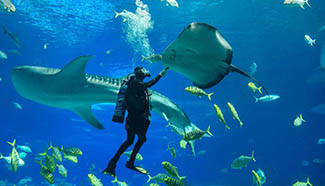BEIJING, March 9 (Xinhua) -- China is developing a manned submersible capable of reaching the deepest known point in the world's oceans, a senior scientist involved in the program said Thursday.
The 11,000-meter deep-sea submersible is planned to conduct its first ocean test in 2021, said Yan Kai, director of the State Key Laboratory of Deep-sea Manned Submersible under the China Ship Scientific Research Center.
Yan, a deputy to the National People's Congress, told Xinhua on the sidelines of the annual legislative session that the submersible is part of the Jiaolong family, whose manned device set China's record of reaching 7,062 meters deep in the Pacific Ocean's Mariana Trench in 2012.
Yan said the record-setting dive boosted the confidence of Chinese scientists in conducting deep-sea research exploration on their own and laid a solid foundation of developing even more sophisticated devices.
The known deepest part of the ocean is the Challenger Deep at a depth of around 11,000 meters in the Mariana Trench.
Submersibles capable of reaching that depth will offer new hopes of setting up deep-sea labs, where scientists can conduct biological, medical and genetic research and explore mineral, oil and gas resources.
But Yan said 11,000-meter submersible research still faces challenges in areas including pressure-resistent materials, design, energy and telecommunications.
Meanwhile, Yan's lab is in the final stages of developing a 4,500-meter submersible to be delivered to its client, the Institute of Deep-sea Science and Engineering under the Chinese Academy of Sciences, in the second half of this year.
The submersible, which was completely designed and made in China, is equipped with five observation windows and can stay underwater for 12 hours, creating favorable conditions for researchers to expand the scope of their observation, according to Yan.
A series of submersibles to dive at a range of 1,000 to 2,000 meters are also being planned.
The scientist put forward a vision of future deep-sea research: a large deep-sea lab, where dozens of people can live and work together for at least two weeks, and even months possibly.
"Humans' understanding of the deep sea is shallower than that of the moon surface," he said. "Conducting scientific research in the deep sea will boost our knowledge about the oceans and Earth."












